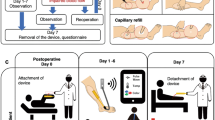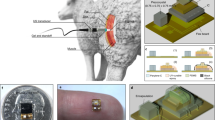Abstract
Tracking of tissue oxygenation around chronic foot wounds may help direct therapy decisions in patients with peripheral artery disease (PAD). Novel sensing technology to enable such monitoring was tested over 9 months in a Sinclair mini-pig model. No adverse events were observed over the entire study period. Systemic and acute hypoxia challenges were detected during each measurement period by the microsensors. The median time to locate the sensor signal was 13 s. Lumee Oxygen microsensors appear safe for long-term repeated oxygen measurements over 9 months.
Access this chapter
Tax calculation will be finalised at checkout
Purchases are for personal use only
Similar content being viewed by others
References
Hirsch A, Criqui M, Treat-Jacobson D et al (2001) Peripheral arterial disease detection, awareness, and treatment in primary care. JAMA 286:1317–1324
Nowygrod R, Egorova N, Greco G et al (2006) Trends, complications, and mortality in peripheral vascular surgery. J Vasc Surg 43:417–418
Stanley J, Veith F, Wakefield T (2014) Current therapy in vascular and endovascular surgery. Elsevier Health Sciences, Philadelphia
Wolfram R, Budinsky A, Pokrajac B et al (2006) Endovascular brachytherapy for prophylaxis of restenosis after femoropopliteal angioplasty: five-year follow-up: prospective randomized study. Radiology 240:878–884
Laird J, Jaff M, Biamino G et al (2005) Cryoplasty for the treatment of femoropopliteal arterial disease: results of a prospective, multicenter registry. J Vasc Inerv Radiol 16:1067–1073
Kasapis C, Henke PK, Chetcuti SJ et al (2009) Routine stent implantation vs. percutaneous transluminal angioplasty in femoropopliteal artery disease: a meta-analysis of randomized controlled trials. Eur Heart J 30:44–55. https://doi.org/10.1093/eurheartj/ehn514
Harrison DK (2002) Optical measurement of tissue oxygen saturation. Int J Lower Extremity Wounds 1:191–201
Thomsen A (2012) The tcpO2 handbook. Radiometer Medical ApS, Brønshøj, Denmark
Anderson C (2010) Noninvasive assessment of lower extremity hemodynamics in individuals with diabetes mellitus. J Vasc Surg 52:76S–80S
Montero-Baker MF, Au-Yeung KY, Wisniewski NA et al (2015) The first-in-man “Si Se Puede” study for the use of micro-oxygen sensors (MOXYs) to determine dynamic relative oxygen indices in the feet of patients with limb-threatening ischemia during endovascular therapy. J Vasc Surg 61:1501–1509. https://doi.org/10.1016/j.jvs.2014.12.060
Wisniewski N, Nichols S, Gamsey S et al (2017) Tissue-integrating oxygen sensors: continuous tracking of tissue hypoxia. Adv Exp Med Biol 977:377–383
Chien JS, Mohammed M, Eldik H et al (2017) Injectable phosphorescence-based oxygen biosensors identify post ischemic reactive hyperoxia. Sci Rep 7:8255. https://doi.org/10.1038/s41598-017-08490-0
Lo LW, Koch CJ, Wilson DF (1996) Calibration of oxygen-dependent quenching of the phosphorescence of Pd-meso-tetra (4-carboxyphenyl) porphine: a phosphor with general application for measuring oxygen concentration in biological systems. Anal Biochem 236:153–160. https://doi.org/10.1006/abio.1996.0144
Acknowledgments
This work was funded in part by R01EB016414, R42HL127933, R44HL134532, and R44HL131366 from the National Institutes of Health, W911NF-16-1-0341, W911NF-11-1-0119 and W31P4Q-12-C-0205 from the Defense Advanced Research Projects Agency and the U.S. Army Research Office. The authors would like to thank Lauren A. Russell and Sierra J. Guidry for pre-clinical support.
Author information
Authors and Affiliations
Corresponding author
Editor information
Editors and Affiliations
Rights and permissions
Copyright information
© 2018 Springer International Publishing AG, part of Springer Nature
About this chapter
Cite this chapter
Nichols, S.P., Balaconis, M.K., Gant, R.M., Au-Yeung, K.Y., Wisniewski, N.A. (2018). Long-Term In Vivo Oxygen Sensors for Peripheral Artery Disease Monitoring. In: Thews, O., LaManna, J., Harrison, D. (eds) Oxygen Transport to Tissue XL. Advances in Experimental Medicine and Biology, vol 1072. Springer, Cham. https://doi.org/10.1007/978-3-319-91287-5_56
Download citation
DOI: https://doi.org/10.1007/978-3-319-91287-5_56
Published:
Publisher Name: Springer, Cham
Print ISBN: 978-3-319-91285-1
Online ISBN: 978-3-319-91287-5
eBook Packages: Biomedical and Life SciencesBiomedical and Life Sciences (R0)




